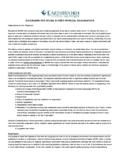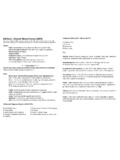Transcription of PUNCH AND SHAVE BIOPSY Robert M. Howse, Jr,
1 Procedure: PUNCH and SHAVE BIOPSY . 939 PUNCH AND SHAVE BIOPSYR obert M. Howse, Jr,Indications1. SHAVE BIOPSY : epidermal lesions such as seborrheicdermatoses, actinic keratoses, warts, skin tags, scabies2. PUNCH BIOPSY : epidermal, intradermal lesions such ascarcinoma, infection, nevi, and autoimmune, para-sitic, and pyogenic granulomasContraindications1. Highly vascular lesions, such as hemangioma2. Benign or self-limited lesions, such as strawberryhemangioma3. Refenal and special treatment required, such as cav-ernous hemangioma, extensive facial basal cell orsquamous cell carcinomaPreparationPatient history and education about lesion, anesthesia,procedure, risks of bleeding, infection, scarring, benefits,follow-up, signature and witness on informed consent,wound care, cosmetic procedures1.
2 Bleeding historya. Aspirin: Prophylactic doses of 325 mg or less aday seldom prevent hemostasis; higher doses maydelay hemostasis but can be managed with l0 tol5 minutes of postoperative Coumarin: If the prothrombin time is within thera-peutic range, achieve hemostasis with l0 to 15minutes of pressure Factor deficiency: Patient must be on Thrombocytopenia: Hemostasis is adequate downto a platelet count of 20,000 unless platelet func-tion is also abnormal ( , idiopathic thrombocy-topenic purpura).2. Tetanus status: Document allergies. To prepare sterilefield, spiral out from lesion with surgical scrub (iso-propyl alcohol is sufficient) and PUNCH BIOPSY patients must keep wound clean anddry for 24 hours. After that, keep wound clean anddry except to gently remove crust with warm soapand water twice a day until the suture removal.
3 Thisminimizes scar Punches, I to 6 mm2. Scalpel3. Blades4. Scissors5. Forceps6. Formalin7. lVo or 2Vo lidocaine with or without epinephrine8. Syringes9. Needles10. Surgical scrubI l. Drapes12. Sterile gloves13. Monofilament suture14. Electric cautery15. AgNO3 sticks. For epidermaldermis will only. Use inAnesthesial. l%o lidocaine if the patient is not allergic2. May use epinephrine if not contraindicated bya. Site: Avoid use in nose, ears, fingers, toes, Medical contraindications: coronary artery disease,i uncontrolled hypertension, allergy3. Preoperative acetaminophen (1000 mg) or ibuprofen(400 mg) t/z to 2 hours prior to procedure4. Postoperative acetaminophen or ibuprofen. Narcoticsare rarely suspicious for melanoma may be better managedby referral to a physician skilled in managing Do not use epinephrine on nose, ears, fingers,toes, or Do not use cautery on the plantar surface ofthe Use universal.
4 XVll Skin DiseasesTechniquePunch BiopsyL Select a PUNCH slightly larger than the lesion if com-plete excision is the goal. Otherwise, plan the punchto be as small as possible and yet obtain adequatetissue for Diagnosis of blistering diseases and keratoacanthomarequires contiguous, normal tissue to be present. Esti-mate the depth of the lesion by its color and Put tension on the skin perpendicular to the observedskin tension lines to create an elliptical the PUNCH with a continuous, clockwise twistto the necessary Repair with monofilament suture matched to skintype and site. Hide the scar along the skin tensionlines; 5- and 6-mm wounds may need two inter-rupted Cleanse the wound, apply a dr5r, nonocclusive dress-ing without medication, creams, or oinfinents to en-hance re-epithelialization without infection and pre-vent scar widening from direct cellular Biopsyl.
5 Seborrheic keratosis: Carefully grasp seborrheic kera-toses with forceps, and gently remove by gliding thescalpel blade parallel to the skin surface at the levelof the Venuca (warts)a. SHAVE verruca and further pare until punctatebleeding Light cautery followed by scraping our the resid-ual, sticky material will destroy the remainingwart. Do not use cautery on plantar warts becauseit may induce painful, permanent Mild acids or vesicants, such as trichloroaceticacid lOVo to 35Eo or salicylic acid paste or plaster,may be applied and weekly paring continued untilthe wart is Actinic keratosisRemove actinic keratoses by scraping with a bladeheld perpendicularly to the the buttery material into a specimen con-tainer to confirm the diasnosis and rule out basalGently extract the tissue columnremove it from the its base in thewith scissors or a scalpel forceps andsubepidermal fatcell carcinoma.
6 The usual tensile resistance of theunderlying normal tissue is felt against the bladewhen all the actinic tissue has been cautery destroys any remaining abnormalcells and is cleansing, apply a dry, nonocclusive dressingwithout medication, creams, or,ointments to allowre-epithelialization without and preventscar widening from cellular at 5 to 10 days based on the expected time forsuture removal or crust resolution,1. Inspect for infection and tensile Remove sutures; alternate if Discuss pathology. Malignant lesions minimally re-quire yearly follow-up with a complete body inven-tory. Refer as Review cosmetic : PUNCH and SHAVE BIOPSY . 94 LRub wound gently with hand cream at least twice aday for 6 weeks and up to 1 year. This alleviatesredness and minimizes the thickness and sdffness ofthe Gently remove crust with wann soap and water tominimize scar Protect from ultraviolet (UV) radiation with sun-screen 40 for I year until scar repigmentation TB, Eisen AZ, Wolff K, et al: Dermatology in Gen-eral Medicine.
7 New York, McGraw-Hill, 1979, pp TB, Polano MK, Suurmond D: Color Atlas andSynopsis of Clinical Dermatology. New York, McGraw-Hill, AG, Goodman LS, Gilman A: Goodman and Gilman'sThe Pharmacological Basis of Therapeutics. New York, Mac-millan, 1985, p SL, Hurley FU: Dermatology, vols I and 2. Philadel-phia, WB Saunders, 1985, pp






